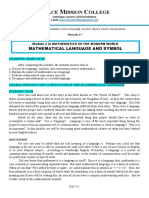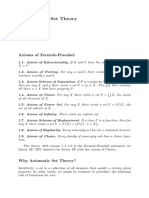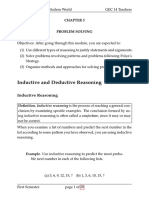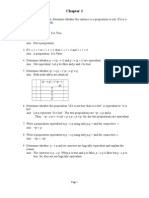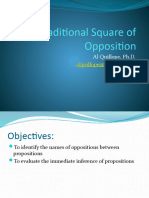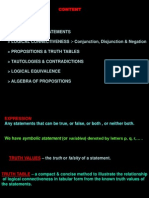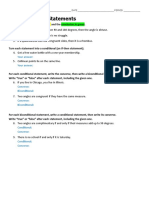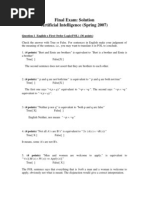Chapter 2
Chapter 2
Uploaded by
Gerckey RasonabeCopyright:
Available Formats
Chapter 2
Chapter 2
Uploaded by
Gerckey RasonabeCopyright
Available Formats
Share this document
Did you find this document useful?
Is this content inappropriate?
Copyright:
Available Formats
Chapter 2
Chapter 2
Uploaded by
Gerckey RasonabeCopyright:
Available Formats
Mathematics in the Modern World GEC 14 Teachers
Chapter 2
Logical Statements
Objectives
After going through this module, you are expected to:
(1) Apply the principles of logic to tell sound from unsound reasoning
in everyday discourse.
(2) Construct truth tables for logical expressions; test statements for
logical equivalence and represent mathematical statements using
logical connectives
(3) Apply notions on logic in real world problems.
(4) Appreciate mathematics in its pure form.
Logic is used to establish the validity of arguments. It is not so much
concerned with what the argument is about but more with providing
rules so that the general form of the argument can be judged as sound or
unsound.
2.1 Propositions and Truth Values
Definition 2.1.1. A proposition is a declarative sentence which is either
true or false, but not both simultaneously. Propositions are sometimes
called statements.
The following are examples of propositions.
(1) This rose is white.
(2) Triangles have four vertices.
(3) 3 + 3 = 4.
(4) 6 < 24.
(5) In the realm of integers, there is this so called the largest prime
number of them all.
Exclamations, questions and demands are not propositions since they
cannot be identified as either true or false.
The following are examples which are not propositions.
(1) Keep off the grass.
(2) Long live the Queen!
(3) Did you go to Jane’s party?
(4) Don’t say that.
First Semester page 1 of 17 CMU Mathematics Department
Mathematics in the Modern World GEC 14 Teachers
Example 2.1.2. Which of the following is/are not a proposition/s?
(1) 1 is a prime number.
(2) Run.
(3) Please stay at home.
(4) π is a real number.
Answer : Items 2 and 3 are not propositions.
Example 2.1.3. Each of the following statements is a proposition. Can
you tell which are true, and which are false?
(1) 5 < −8
(2) The square of −1 is negative.
(3) 2 + 8 = 10
√
(4) 2 is a rational number.
Answer :
(1) False.A positive number is always greater than a negative number.
(2) False. The square of a negative number is always positive.
(3) True. √
(4) False. 2 is not a rational number since it cannot be expressed as
a quotient of two integers.
2.2 Logical Connectives and Truth tables
The truth (T) or falsity (T) of a proposition is called truth value. A
table which summarizes truth values of propositions is called a truth table.
Simple propositions make only a single statement. These can be
combined to form a compound propositions. Thus, compound
propositions are simply composed of linked simple propositions and in
this notion, these simple proposition is called the components of the
compound statement. The operations which are used to link pairs of
propositions are called logical connectives and the truth value of any
compound proposition is completely determined by
• the truth tables of its component simple propositions, and
• the particular connective, or connectives, used to link them.
Propositions are conventionally symbolized using the letters
p, q, r, . . .. We shall adopt the latter convention throughout the rest of
the discussions.
First Semester page 2 of 17 CMU Mathematics Department
Mathematics in the Modern World GEC 14 Teachers
Negation
It has the effect of reversing the truth value of the proposition. We
state the negation of a proposition by prefixing it “It is not the case that
...”.
If p symbolizes a proposition, ∼ p symbolizes the negation of p.
The following truth table gives the truth values for ∼ p.
p ∼p
T F
F T
Example 2.2.1. Write the negation of each of the following statements.
(1) π is a rational number.
(2) 4 is an even integer.
(3) x = 2.
(4) 4 < 5.
Answer :
(1) π is not a rational number, or π is an irrational number.
(2) 4 is not an even integer, or 4 is an odd integer.
(3) x 6= 2.
(4) 4 6< 5, or 4 ≥ 5.
Quantifiers
In a statement, the word some and the phrases there exists and at
least one are called existential quantifiers. On one hand, the words,
all, none, no, and every are called universal quantifiers.
The table below presents the negation of a quantified statements
Statement Negation
All X are Y Some X are not Y
No X are Y Some X are Y
Some X are not Y All X are Y
Some X are Y No X are Y
Example 2.2.2. Write the negation of the proposition “All numbers are
even”.
Solution: The following are some examples of negation of the given
proposition.
First Semester page 3 of 17 CMU Mathematics Department
Mathematics in the Modern World GEC 14 Teachers
(1) It is not the case that all numbers are even.
(2) Not all numbers are even.
(3) Some numbers are not even.
(4) Some numbers are odd.
Example 2.2.3. Write the negation of each of the following statements:
(1) Some men in Valencia City are positive in Covid.
(2) All integers are rational numbers.
Solution:
(1) No one in Valencia City is a positive in covid.
(2) Some integers are not rational numbers.
Definition 2.2.4. Two simple propositions that are linked using the
word “and” result a new propostition which is called a conjuntive
proposition. The process of using the said logical connective “and” is
called a conjunction. Truth value for this compound proposition is true
whenever both of its components are true; Otherwise, it is false. If p and
q are two propositions, p ∧ q symbolizes the conjunction of p and q. One
can also use the words but, although, however, with, whereas, and
the likes, for conjunction.
The truth table for this compound proposition is as follows:
p q p∧q
T T T
T F F
F T F
F F F
Example 2.2.5.
p : The sun is shining.
q : Pigs eat turnips.
p ∧ q : The sun is shining and pigs eat turnips.
The following are also conjunctions of p and q.
(1) The sun shines but pigs eat turnips.
(2) Although the sun shines, pigs eat turnips.
(3) The sun shines whereas pigs eat turnips.
First Semester page 4 of 17 CMU Mathematics Department
Mathematics in the Modern World GEC 14 Teachers
Definition 2.2.6. The word “or” when used to link two simple
propositions result a new compound proposition called disjunctive
proposition. The process in using this connective is called disjunction. A
disjunction is generally, inclusive in a sense that the compound
disjunctive proposition is true whenever atleast one of its simple
proposition is true. If p and q are two propositions, p ∨ q symbolizes the
inclusive disjunction of p and q. A disjunctive proposition is said to be
exclusive if exactly one of its simple propositions is true. The exclusive
disjunction of p and q is denoted by p∨¯ q.
The following truth table gives the truth values of p ∨ q.
p q p∨q
T T T
T F T
F T T
F F F
¯ q.
The following truth table gives the truth values of p∨
p q ¯q
p∨
T T F
T F T
F T T
F F F
Example 2.2.7. Consider the following compound propositions:
(1) Tomorrow at 8:00am, I will go swimming at the beach or I will climb
at the Musuan Peak.
(2) Either I prefer cofee or milk as part of my morning routine.
(3) A person that is infected by a SARS-Cov-2 is either symptomatic
or asymtomatic.
(4) Applicants for this post must be over 25 or have at least 3 years
relevant experience.
On (1) in the example above, the proposition is exclusive since one cannot
do both swimming in the beach while climbing on the Musuan Peak. The
same observation applies to (3). While both (2) and (4) are inclusive.
Definition 2.2.8. The conditional connective (sometimes called
implication) which is denoted by =⇒ is the compound proposition of
the form “p implies q” or “If p, then q”. In the conditional proposition
First Semester page 5 of 17 CMU Mathematics Department
Mathematics in the Modern World GEC 14 Teachers
p =⇒ q, p is called the antecedent and q the consequent. The
proposition p is said to be a sufficient condition for q, and q a necessary
condition for p. This compound statement is true except when the
antecedent is true and the consequent is false.
The following is the truth table for p =⇒ q:
p q p =⇒ q
T T T
T F F
F T T
F F T
Example 2.2.9. Consider the following:
p : I eat breakfast.
q : I don’t eat lunch.
p =⇒ q : If I eat breakfast, then I don’t eat lunch.
The following are also alternative expressions for p =⇒ q.
(1) I eat breakfast only if I don’t eat lunch.
(2) Whenever I eat breakfast, I don’t eat lunch.
(3) That I eat breakfast implies that I don’t eat lunch.
On Example 2.2.9, the antecedent is the statement “I eat breakfast”
while the consequent is the proposition “I don’t eat lunch”.
Definition 2.2.10. For propositions p and q, the biconditional
proposition with respect to p and q is the proposition of the form “p if,
and only if q”. Here, the biconditional proposition is true whenever both
of its components have the same truth value; Otherwise, it is false.
The truth table for p ⇐⇒ q is given by:
p q p ⇐⇒ q
T T T
T F F
F T F
F F T
First Semester page 6 of 17 CMU Mathematics Department
Mathematics in the Modern World GEC 14 Teachers
Example 2.2.11.
p : I eat breakfast.
q : I don’t eat lunch.
p ⇐⇒ q : I eat breakfast of and only if I don’t eat lunch
(or alternatively, If and only if I eat breakfast,
then I don’t eat lunch) .
2.3 Working with Truth Tables and its Applications
In this section, we now turn on some methods in constructing truth
table for combinations of conjunctions, disjunctions, negations,
implications, and biconditional statements.
The Standard Truth Table Form is as follows:
p q Given statement
T T
T F
F T
F F
The technique for the construction of a truth value is to “work by parts
to whole”. First, write all the number of combination of truth values of
the given components. Note that for two components, there should be
22 = 4 rows and for compound proposition with three component should
have 23 = 8 rows. Next, is to supplement the truth values by parts to
whole. To see this, consider the following examples.
Example 2.3.1. Construct a truth table for ∼ (∼ p ∨ q) ∨ p.
Solution: Here, it’s suitable to start with working on the truth table for
∼ p.
p q ∼p
T T F
T F F
F T T
F F T
The next step is to supplement ∼ p ∨ q. Here, combine the third and
second column of the latter table:
First Semester page 7 of 17 CMU Mathematics Department
Mathematics in the Modern World GEC 14 Teachers
p q ∼p ∼p∨q
T T F T
T F F F
F T T T
F F T T
The next step is to negate the fourth column of the latter table:
p q ∼p ∼p∨q ∼ (∼ p ∨ q)
T T F T F
T F F F T
F T T T F
F F T T F
Finally, combine via disjunction fifth and first column of the table
above:
p q ∼p ∼p∨q ∼ (∼ p ∨ q) ∼ (∼ p ∨ q) ∨ p
T T F T F T
T F F F T T
F T T T F F
F F T T F F
Example 2.3.2. Construct a truth table for ∼ (p ∨ ∼ q) ∧ (∼ p ∨ q).
Negate the first column:
p q ∼p
T T F
T F F
F T T
F F T
Negate the second column of the table above:
p q ∼p ∼q
T T F F
T F F T
F T T F
F F T T
First Semester page 8 of 17 CMU Mathematics Department
Mathematics in the Modern World GEC 14 Teachers
Disjunct First and Fourth column of the latter table:
p q ∼p ∼q p∨∼q
T T F F T
T F F T T
F T T F F
F F T T T
Disjunct third and second column:
p q ∼p ∼q p∨∼q ∼p∨q
T T F F T T
T F F T T F
F T T F F T
F F T T T T
Negate the fifth column:
p q ∼p ∼q p∨∼q ∼p∨q ∼ (p ∨ ∼ q)
T T F F T T F
T F F T T F F
F T T F F T T
F F T T T T F
Lastly, conjunct sixth and seventh column:
∼ (p ∼ (p ∨ ∼ q)
p q ∼p ∼q p∨∼q ∼p∨q
∨ ∼ q) ∧(∼ p ∨ q)
T T F F T T F F
T F F T T F F F
F T T F F T T T
F F T T T T F F
Now, we will work on constructing truth table for three statements.
Recall that the truth table must consist of exactly 8 number of rows to
start with.
Example 2.3.3. Construct truth table for ∼ (p =⇒ ∼ (q ∨ r))
Solution: It is suitable to start with q ∨ r and then negate it:
First Semester page 9 of 17 CMU Mathematics Department
Mathematics in the Modern World GEC 14 Teachers
p q r q∨r ∼ (q ∨ r)
T T T T F
T T F T F
T F T T F
F T T T F
T F F F T
F T F T F
F F T T F
F F F F T
Finally, work on p =⇒ ∼ (q ∨ r) and its negation.
p =⇒ ∼ (p =⇒
p q r q∨r ∼ (q ∨ r)
∼ (q ∨ r) ∼ (q ∨ r))
T T T T F F T
T T F T F F T
T F T T F F T
F T T T F T F
T F F F T T F
F T F T F T F
F F T T F T F
F F F F T T F
Definition 2.3.4. Two statements p and q are equivalent if they both
both have the same truth value for all possible truth values of their simple
propositions. Here, we write p ≡ q.
Example 2.3.5. Construct a truth table for ∼ p ∨ q.
Solution:
p q ∼p ∼p∨q
T T F T
T F F F
F T T T
F F T T
Recall that the truth value table for p =⇒ q was given as
First Semester page 10 of 17 CMU Mathematics Department
Mathematics in the Modern World GEC 14 Teachers
p q p =⇒ q
T T T
T F F
F T T
F F T
This is exaclty the same as the truth table for ∼ p ∨ q, i.e.,
p q ∼p ∼p∨q p =⇒ q
T T F T T
T F F F F
F T T T T
F F T T T
Thus, by Definition 2.3.4, p =⇒ q ≡ ∼ p ∨ q.
Remark 2.3.6. Given statements p and q, p =⇒ q ≡ ∼ p ∨ q.
Example 2.3.7. “In a 2-dimensional plane, two lines are either not
parallel or they do not intersect” is just logically equivalent to “If two
lines in a 2-dimensional plane are parallel, then they do not intersect”. ”
Example 2.3.8. Show that the De Morgan’s Laws stated below hold.
∼ (p ∧ q) ≡ ∼ p ∨ ∼ q and ∼ (p ∨ q) ≡ ∼ p ∧ ∼ q
To show this, we will investigate if conditions of Definition 2.3.4 is
satisfied. Observe that
p q ∼p ∼q p∧q ∼ (p ∧ q) ∼p∨∼q
T T F F T F F
T F F T F T T
F T T F F T T
F F T T F T T
and
p q ∼p ∼q p∨q ∼ (p ∨ q) ∼p∧∼q
T T F F T F F
T F F T T F F
F T T F T F F
F F T T F T T
First Semester page 11 of 17 CMU Mathematics Department
Mathematics in the Modern World GEC 14 Teachers
Theorem 2.3.9. Given a statement p, p ≡∼ (∼ p).
Proof : Let p be a proposition. Observe that
p ∼p ∼ (∼ p)
T F T
T F T
F T F
F T F
Observe that by Remark 2.3.6, we have ∼ (p =⇒ q) ≡ ∼ (∼ p ∨ q).
Now by De Morgan’s Law, ∼ (∼ p ∨ q) ≡ ∼ (∼ p)∧ ∼ q. By Theorem
2.3.9, ∼ (∼ p)∧ ∼ q ≡ p ∧ ∼ q. These imply ∼ (p =⇒ q) ≡ p ∧ ∼ q.
Remark 2.3.10. For statements p and q, ∼ (p =⇒ q) ≡ p ∧ ∼ q.
Definition 2.3.11. Let p and q be statements.
1. The converse of p =⇒ q is q =⇒ p;
2. The inverse of p =⇒ q is ∼ p =⇒ ∼ q; and
3. The contrapositive of p =⇒ q is ∼ q =⇒ ∼ p.
Example 2.3.12. Write the converse, inverse, and contrapositive of the
statement “If x = 2, then x2 = 4.”
Solution: The given is a conditional statement. Let p : x = 2 and
q : x2 = 4. Then ∼ p : x 6= 2 and ∼ q : x2 6= 4. The converse (of the form
q =⇒ p) is
“If x2 = 4, then x = 2.”
The inverse (of the form ∼ p =⇒ ∼ q) is
“If x 6= 2, then x2 6= 4.”
The contrapositive (of the form ∼ q =⇒ ∼ p) is
“If x2 6= 4, then x 6= 2.”
Example 2.3.13. Show that a conditional statement p =⇒ q is not
necessarily equivalent to its converse, that is, p =⇒ q 6≡ q =⇒ p.
Solution: Observe that
First Semester page 12 of 17 CMU Mathematics Department
Mathematics in the Modern World GEC 14 Teachers
p q p =⇒ q q =⇒ p
T T T T
T F F T
F T T F
F F T T
This means that p =⇒ q 6≡ q =⇒ p. In other words, a conditional
statement p =⇒ q is not necessarily equivalent to its converse.
Example 2.3.14. Show that a conditional statement is always equivalent
to its contrapositive, that is, (p =⇒ q) ≡ (∼ q =⇒ ∼ p).
Solution: Observe that
p q ∼p ∼q p =⇒ q ∼ q =⇒ ∼ p
T T F F T T
T F F T F F
F T T F T T
F F T T T T
This means that (p =⇒ q) ≡ (∼ q =⇒ ∼ p), that is, a conditional
statement is always equivalent to its contrapositive.
Exercise 1. Investigate if p =⇒ q is equivalent to its inverse.
First Semester page 13 of 17 CMU Mathematics Department
Mathematics in the Modern World GEC 14 Teachers
2.4 Practice Exercises
(1) Write the negation of each of the following statements.
(a) All classes in CMU should be online.
(b) Some students in CMU are kind.
(c) No one in the students in GEC 14 fails in their final exam.
(2) Consider the following propositions:
p : 2 is a prime number.
q : 3 is a factor of 6.
Write the compound propositions symbolized by
(a) p∨∼q
(b) ∼ (q ∧ p)
(c) ∼ p =⇒ q
(d) ∼ p ⇐⇒ ∼ q
(3) Let p be the proposition “Today is my birthday” and q be “I’ll go
to Paris”. Write the following propositions symbollically.
(a) If today is my birthday, then I won’t go to Paris.
(b) Today is my birthday or I’ll go to Paris.
(c) I’ll go to Paris and today is not my birthday.
(d) If and only if today is not my birthday then I’ll go to Paris.
(4) Write the converse, inverse, and contrapositive of the statement “If
x > 1, then x2 > 1.”
(5) Construct truth tables for the following compound propositions.
(a) ∼p∨q
(b) ∼p∧∼q
(c) ∼ q =⇒ p
(d) ∼ p ⇐⇒ ∼ q
(6) Construct truth tables for
(a) p =⇒ (q ∧ r)
(b) (∼ p ∨ q) ⇐⇒ ∼ r
First Semester page 14 of 17 CMU Mathematics Department
Mathematics in the Modern World GEC 14 Teachers
Answer Key
(1) Write the negation of each of the following statements.
(a) All classes in CMU should be online.
Some classes in CMU should not be done online.
(b) Some students in CMU are kind.
All students in CMU are not kind. or alternatively, No students
in CMU are kind.
(c) No one in the students in GEC 14 fails in their final exam.
Some students in GEC 14 fails in their exam.
(2) Consider the following propositions:
p : 2 is a prime number.
q : 3 is a factor of 6.
Write the compound propositions symbolized by
(a) p ∨ ∼ q: 2 is a prime number or 3 is not a factor of 6.
(b) ∼ (q ∧ p): It is not the case that 3 is a factor of 6 and 2 is a
prime number.
(c) ∼ p =⇒ q: If 2 is not a prime number, then 3 is a factor of 6.
(d) ∼ p ⇐⇒ ∼ q: 2 is not a prime number if and only if 3 is not
a factor of 6.
(3) Let p be the proposition “Today is my birthday” and q be “I’ll go
to Paris”. Write the following propositions symbollically.
(a) If today is my birthday, then I won’t go to Paris. p =⇒ ∼ q
(b) Today is my birthday or I’ll go to Paris. p ∨ q
(c) I’ll go to Paris and today is not my birthday. q∧ ∼ p
(d) If and only if today is not my birthday then I’ll go to Paris.
∼ p ⇐⇒ q
(4) Write the converse, inverse, and contrapositive of the statement “If
x > 1, then x2 > 1.”
Answer :
converse: If x2 > 1, then x > 1.
inverse: If x 6> 1, then x2 6> 1, or If x ≤ 1, then x2 ≤ 1.
contrapositive: If x2 6> 1, then x 6> 1, or If x2 ≤ 1, then x ≤ 1.
(5) Construct truth tables for the following compound propositions.
(a) ∼ p ∨ q
First Semester page 15 of 17 CMU Mathematics Department
Mathematics in the Modern World GEC 14 Teachers
p q ∼p ∼p∨q
T T F T
T F F F
F T T T
F F T T
(b) ∼ p ∧ ∼ q
p q ∼p ∼q ∼ p∧ ∼ q
T T F F F
T F F T F
F T T F F
F F T T T
(c) ∼ q =⇒ p
p q ∼q ∼ q =⇒ p
T T F T
T F T T
F T F T
F F T F
(d) ∼ p ⇐⇒ ∼ q
p q ∼p ∼q ∼ p ⇐⇒ ∼ q
T T F F T
T F F T F
F T T F F
F F T T T
(6) Construct truth tables for
(a) p =⇒ (q ∧ r)
p q r q∧r p =⇒ (q ∧ r)
T T T T T
T T F F F
T F T F F
T F F F F
F T T T T
F T F F T
F F T F T
F F F F T
First Semester page 16 of 17 CMU Mathematics Department
Mathematics in the Modern World GEC 14 Teachers
(b) (∼ p ∨ q) ⇐⇒ ∼ r
p q r ∼p ∼p∨q ∼r (∼ p ∨ q) ⇐⇒ ∼ r
T T T F T F F
T T F F T T T
T F T F F F T
T F F F F T F
F T T T T F F
F T F T T T T
F F T T T F F
F F F T T T T
References
[1] Baltazar, Ragasa, & Evangelista, Mathematics in the Modern World,
C&E Publishing, 2018.
[2] Garnier, Rowan, Discrete Mathematics: for New Technology, IOP
Publishing Ltd 2002.
First Semester page 17 of 17 CMU Mathematics Department
You might also like
- Module 2 Mathematical Language and SymbolsDocument34 pagesModule 2 Mathematical Language and SymbolsBocchi VyNo ratings yet
- Math in The Modern World - Syllabus 2019 - 2020Document6 pagesMath in The Modern World - Syllabus 2019 - 2020Merideth VillaluzNo ratings yet
- Math in Our World - Module 3.1Document10 pagesMath in Our World - Module 3.1Gee Lysa Pascua Vilbar100% (1)
- 1990 - Margaris - First Order Mathematical LogicDocument121 pages1990 - Margaris - First Order Mathematical Logicradutari100% (2)
- Topic 1.1 Proposition LogicDocument7 pagesTopic 1.1 Proposition LogicNawrah Alwani Mohd YusoffNo ratings yet
- Name: - Date: - Section: - ScoreDocument3 pagesName: - Date: - Section: - ScoreJohn Richmond CadagNo ratings yet
- Measures of Central Tendency: Mean, Median and ModeDocument19 pagesMeasures of Central Tendency: Mean, Median and ModeJakmensar Dewantara SiagianNo ratings yet
- GEED 10053 Quiz 2Document3 pagesGEED 10053 Quiz 2acurvz2005100% (2)
- Module 3 Topic 3 Lesson 1 Modelling With GraphsDocument22 pagesModule 3 Topic 3 Lesson 1 Modelling With GraphsFatimah Rahima JingonaNo ratings yet
- Derivatives: Differentiation RulesDocument36 pagesDerivatives: Differentiation RulesChristine EvangelistaNo ratings yet
- Math PPT Module 5Document21 pagesMath PPT Module 5emmah macalNo ratings yet
- Module 2 Mathematics in The Modern WorldDocument16 pagesModule 2 Mathematics in The Modern WorldJeorge Ornedo Hugno100% (1)
- Gen Math ExamDocument2 pagesGen Math ExamJeffrey ChanNo ratings yet
- Week 3-4 Gec Chapter 3 PROBLEM SOLVING AND REASONINGDocument7 pagesWeek 3-4 Gec Chapter 3 PROBLEM SOLVING AND REASONINGShela RamosNo ratings yet
- Mathematics in The Modern World Answer KeyDocument2 pagesMathematics in The Modern World Answer KeyPrincess LozadaNo ratings yet
- Anti DerivativesDocument7 pagesAnti DerivativesHimanshu GuptaNo ratings yet
- 01-Axioms of Set TheoryDocument13 pages01-Axioms of Set TheorySubhajit ChakrabortyNo ratings yet
- 5.1 Mathematical SystemsDocument44 pages5.1 Mathematical SystemsDaniel Luis AguadoNo ratings yet
- History of Mathematics Prelim ModuleDocument6 pagesHistory of Mathematics Prelim ModuleMary May C. MantoNo ratings yet
- 29 - 30 Prelim Mathematics in The Modern WorldDocument12 pages29 - 30 Prelim Mathematics in The Modern WorldJohn Lorenzo BetitaNo ratings yet
- MODULE Math in The Modern WorldDocument7 pagesMODULE Math in The Modern WorldReymond CuisonNo ratings yet
- Chapter 2 Lesson 2Document34 pagesChapter 2 Lesson 2Albert L. AcademiaNo ratings yet
- Number Theory WorksheetDocument2 pagesNumber Theory WorksheetSharlyn BalgoaNo ratings yet
- Lesson: 5 Mathematics in The Modern WorldDocument12 pagesLesson: 5 Mathematics in The Modern WorldJayson DSNo ratings yet
- Mathematics in The Modern WorldDocument61 pagesMathematics in The Modern WorldEvasco, Lovely I.No ratings yet
- Math ActivityDocument2 pagesMath ActivityBrendan Lewis DelgadoNo ratings yet
- Histograms, Frequency Polygons and Ogives: Most Common GraphsDocument3 pagesHistograms, Frequency Polygons and Ogives: Most Common GraphsFajrul Hisyam100% (1)
- GED Lesson Exercise 2 - GONZALESDocument3 pagesGED Lesson Exercise 2 - GONZALESAdolph Christian GonzalesNo ratings yet
- Computing Truth Values: Symbolic LogicDocument54 pagesComputing Truth Values: Symbolic LogicRuby SapitanNo ratings yet
- Module 6Document21 pagesModule 6cris laslasNo ratings yet
- Activity 2.1 MMWDocument1 pageActivity 2.1 MMWJ Saint BadeNo ratings yet
- Math 211 Calculus Ii NotesDocument24 pagesMath 211 Calculus Ii Notesmaikarageorge721No ratings yet
- Content Discussion: The Nature of MathematicsDocument7 pagesContent Discussion: The Nature of MathematicsJeffrey TuballaNo ratings yet
- Come Together: Measures of Central Tendency For Grouped DataDocument1 pageCome Together: Measures of Central Tendency For Grouped DataJerson MadronaNo ratings yet
- LOGIC - Truth Table and TautologyDocument22 pagesLOGIC - Truth Table and TautologyDanz Khrenzo V. EstabilloNo ratings yet
- Quiz # 1Document2 pagesQuiz # 1glenville genanibanNo ratings yet
- All Lawyers Drive Bmws. Susan Is A Lawyer. Therefore, Susan Drives A BMWDocument3 pagesAll Lawyers Drive Bmws. Susan Is A Lawyer. Therefore, Susan Drives A BMWJackie EasterNo ratings yet
- Mathematics in The Modern World - OBE - SyllabusDocument6 pagesMathematics in The Modern World - OBE - SyllabusJoseph MazoNo ratings yet
- Module 3: Problem Solving and Reasoning: What Are The Skills Developed Through Problem Solving?Document2 pagesModule 3: Problem Solving and Reasoning: What Are The Skills Developed Through Problem Solving?Francis RosalesNo ratings yet
- Limits Involving Trigonometric FunctionsDocument26 pagesLimits Involving Trigonometric FunctionsJewel EspirituNo ratings yet
- Logic 4Document24 pagesLogic 4Kim Abigelle GarciaNo ratings yet
- 4.2 Descriptive Statistics in ExcelDocument26 pages4.2 Descriptive Statistics in ExcelprincessNo ratings yet
- Language of SetsDocument17 pagesLanguage of Setsleslie jane archivalNo ratings yet
- Lesson 13-Trigonometric IdentitiesDocument31 pagesLesson 13-Trigonometric IdentitiesCristina Aguilar-No ratings yet
- Lecture Notes in GEd 102 Mathematics in The Modern WorldDocument49 pagesLecture Notes in GEd 102 Mathematics in The Modern WorldMae Del FraneNo ratings yet
- Gen Math Mod2Document10 pagesGen Math Mod2Rhianne CayaoNo ratings yet
- Chapter 3Document41 pagesChapter 3Diana100% (3)
- Fourth Periodical Test Bacis Calculus TEST QUESTIONDocument4 pagesFourth Periodical Test Bacis Calculus TEST QUESTIONByron Jiel AgbayaniNo ratings yet
- Relations and FunctionsDocument32 pagesRelations and Functionsangelmusic27No ratings yet
- Mathematical Language and SymbolsDocument3 pagesMathematical Language and SymbolsHyacinth MartinezNo ratings yet
- Chapter 10 - LogicDocument40 pagesChapter 10 - LogicJoelle Patricia ManaliliNo ratings yet
- Inductive and Deductive ReasoningDocument35 pagesInductive and Deductive Reasoningdreiriego2003No ratings yet
- 3.0 - Problem Solving 1Document20 pages3.0 - Problem Solving 1princess50% (2)
- LESSON 14: Slope of A Curve, Tangent, and Normal LineDocument8 pagesLESSON 14: Slope of A Curve, Tangent, and Normal LineYzeNo ratings yet
- 2022 DIVISION STATISTICS MONTH CELEBRATION With AnswersDocument6 pages2022 DIVISION STATISTICS MONTH CELEBRATION With AnswersDan Lexter LaulitaNo ratings yet
- Simple Annuity 1Document13 pagesSimple Annuity 1Kelvin BarceLon0% (1)
- Diagnostic Test General MathematicsDocument4 pagesDiagnostic Test General MathematicsGeraldine Gementiza PoliquitNo ratings yet
- College of Teacher Education and Human Sciences Preliminary Exam Math in The Modern World Second Semester S.Y. 2019-2020Document1 pageCollege of Teacher Education and Human Sciences Preliminary Exam Math in The Modern World Second Semester S.Y. 2019-2020Maryjoy FerrerNo ratings yet
- Spoc Activity 2 Golden RatioDocument3 pagesSpoc Activity 2 Golden RatioJerry P. PagtalunanNo ratings yet
- NAT Reviewer Statistics and Probability For PrintingDocument6 pagesNAT Reviewer Statistics and Probability For PrintingJett Bernardo CortezNo ratings yet
- Chapter 3Document18 pagesChapter 3Leewyn Pitonang AranasNo ratings yet
- Philippine Accounting Standard 2Document32 pagesPhilippine Accounting Standard 2Gerckey RasonabeNo ratings yet
- Chapter 4 StatisticsDocument16 pagesChapter 4 StatisticsGerckey RasonabeNo ratings yet
- Chapter 3 - Problem SolvingDocument28 pagesChapter 3 - Problem SolvingGerckey RasonabeNo ratings yet
- PoliticalselfDocument21 pagesPoliticalselfGerckey RasonabeNo ratings yet
- GERCKEY RASONABE - Activity 1Document2 pagesGERCKEY RASONABE - Activity 1Gerckey RasonabeNo ratings yet
- EssayDocument1 pageEssayGerckey RasonabeNo ratings yet
- Write An Essay On How Mathematics Can Help You Succeed in Your Chosen Field of Specialization (Your Course) and Subsequently in Your Future CareerDocument1 pageWrite An Essay On How Mathematics Can Help You Succeed in Your Chosen Field of Specialization (Your Course) and Subsequently in Your Future CareerGerckey RasonabeNo ratings yet
- StoryDocument5 pagesStoryGerckey RasonabeNo ratings yet
- The Aswang PhenomenonDocument2 pagesThe Aswang PhenomenonGerckey RasonabeNo ratings yet
- Forms of Small Business OwnershipDocument26 pagesForms of Small Business OwnershipGerckey Rasonabe100% (2)
- 2 2 LogicDocument14 pages2 2 LogicMatesDonSantosNo ratings yet
- Inference Rules 08Document61 pagesInference Rules 08alsnNo ratings yet
- C H A P T e R 2Document13 pagesC H A P T e R 2Ronald Chen0% (1)
- Chapter 1: Formal Logic: Tannaz R.Damavandi Cal Poly PomonaDocument52 pagesChapter 1: Formal Logic: Tannaz R.Damavandi Cal Poly PomonaCLNo ratings yet
- AI Notes Part-4Document20 pagesAI Notes Part-4Divyanshu PatwalNo ratings yet
- Aaron Cotnoir - Nagarjuna's LogicDocument17 pagesAaron Cotnoir - Nagarjuna's Logicthewitness3100% (1)
- CSI30 Chapter - 01 ProblemsDocument5 pagesCSI30 Chapter - 01 ProblemsLuIs I. GuTiNo ratings yet
- Chapter 1 - Formal LogicDocument27 pagesChapter 1 - Formal LogicαllєfταωєNo ratings yet
- WK 3 Lesson 2 Discrete 2Document52 pagesWK 3 Lesson 2 Discrete 2harlem3212No ratings yet
- Lecture 1 2Document42 pagesLecture 1 2raquibNo ratings yet
- 6 The Traditional Square of OppositionDocument52 pages6 The Traditional Square of OppositionMeah Angela GulacNo ratings yet
- Unit IV - Knowledge AgentsDocument42 pagesUnit IV - Knowledge AgentsMuthukumaran CNo ratings yet
- JEE Main Mathematical Reasoning Previous Year Questions With SolutionsDocument6 pagesJEE Main Mathematical Reasoning Previous Year Questions With SolutionsvikasNo ratings yet
- LogicDocument22 pagesLogicIkah YuyuNo ratings yet
- 2-3 and 2-6 HWDocument4 pages2-3 and 2-6 HWlauren roNo ratings yet
- Lecture Notes in Discrete MathematicsDocument220 pagesLecture Notes in Discrete Mathematicsjpaulino100% (4)
- The First Order Predicate Logic (FOPL)Document20 pagesThe First Order Predicate Logic (FOPL)passwordyNo ratings yet
- MOD 3.1 Propositional LogicDocument80 pagesMOD 3.1 Propositional LogicGUNEET SURANo ratings yet
- Resolution Theorem Proving: Propositional Logic: 6.825 Techniques in Artificial IntelligenceDocument84 pagesResolution Theorem Proving: Propositional Logic: 6.825 Techniques in Artificial IntelligenceAjay VasanthNo ratings yet
- Mathematical LogicDocument15 pagesMathematical LogicEfean KimNo ratings yet
- I2209 Propositional LogicDocument55 pagesI2209 Propositional LogicMaktabatiLB PlannersNo ratings yet
- Mfcs NotesDocument95 pagesMfcs NotesShantha KumarNo ratings yet
- Logical Opposition: By: Dequito, I. Hannah Isabela A. Edelainne Joyce MontibonDocument17 pagesLogical Opposition: By: Dequito, I. Hannah Isabela A. Edelainne Joyce MontibonJa DimasNo ratings yet
- PropLogic PDFDocument130 pagesPropLogic PDFrahul kumarrNo ratings yet
- AI - Module IV - PropositionallogicDocument49 pagesAI - Module IV - PropositionallogicNorah ElizNo ratings yet
- Final Exam - SolutionDocument7 pagesFinal Exam - SolutionKshitij Jindal0% (2)
- Unit 2 - Mathematical Language and SymbolsDocument18 pagesUnit 2 - Mathematical Language and SymbolsLady Mairyl N. BrigondoNo ratings yet
- Class XII Boolean Algebra: + B) .C. (A+B) (X' +Z) + ( (Y' +Z) - (X' +y) ) ' 1Document3 pagesClass XII Boolean Algebra: + B) .C. (A+B) (X' +Z) + ( (Y' +Z) - (X' +y) ) ' 1Srijan JaiswalNo ratings yet











